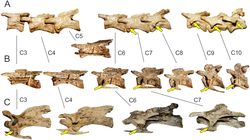| Pantydraco Temporal range: Late Triassic, | |
|---|---|
 | |
| Life reconstruction | |
| Scientific classification | |
| Domain: | Eukaryota |
| Kingdom: | Animalia |
| Phylum: | Chordata |
| Clade: | Dinosauria |
| Clade: | Saurischia |
| Clade: | † Sauropodomorpha |
| Genus: | † Pantydraco Galton et al., 2007 |
| Species: | †P. caducus |
| Binomial name | |
| †Pantydraco caducus (Yates, 2003) Galton et al., 2007 | |
| Synonyms | |
| |
Pantydraco (where "panty-" is short for Pant-y-ffynnon, signifying hollow of the spring/well in Welsh, referring to the quarry at Bonvilston in South Wales where it was found) [1] is a genus of basal sauropodomorph dinosaur from the Late Triassic of the United Kingdom (Wales). It is based on a partial juvenile skeleton once thought to belong to Thecodontosaurus . Only one valid species of Pantydraco is recognised: P. caducus. [2]











